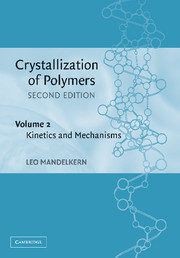13 - Polymer–diluent mixtures
Published online by Cambridge University Press: 15 December 2009
Summary
High molecular weight n-alkanes
The crystallization kinetics of the monodisperse, high molecular weight n-alkanes from solution follows the unique pattern observed in the melt crystallization of such species. The characteristic dependence of the observed rate on the crystallization temperature measured using differential scanning calorimetry is illustrated in Fig. 13.1 for the crystallization of C198H398 from a 3.85% toluene solution. Typically, in crystallization from solution, as well as from the pure melt, the crystallization rate reaches a maximum several degrees below the melting temperature of the extended crystals. A minimum follows, as the temperature is lowered just a few more degrees. The further lowering of the temperature results in a steep increase in the rate. It is easily demonstrated that folded chain crystallites are initially formed at crystallization temperatures in the vicinity of the minimum. Similar inversions in the crystallization rates have been reported for the n-alkanes C246H494 (5) and C294H590 using the same method. Wide-angle x-ray scattering studies, utilizing synchrotron radiation, yield similar results for C162H326 and C246H494 crystallizing from solution. Growth rate studies with C198H398 and higher n-alkanes also show maxima and minima with crystallization temperature, as does the initiation and spreading of a given layer.
In the crystallization of C246H494 from a dilute solution in toluene (0.14% w/w) two minima are observed in the crystallization rate–temperature plot.
- Type
- Chapter
- Information
- Crystallization of Polymers , pp. 380 - 432Publisher: Cambridge University PressPrint publication year: 2004
- 1
- Cited by



